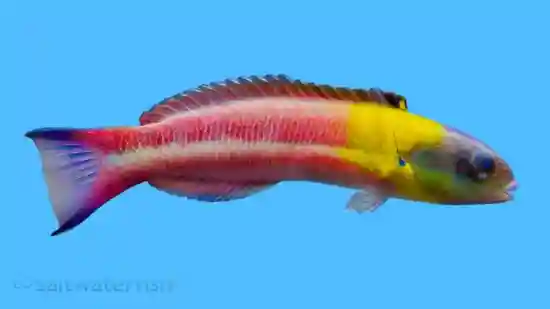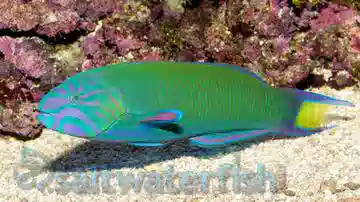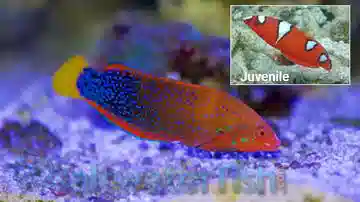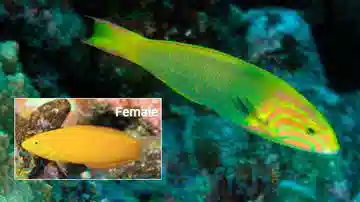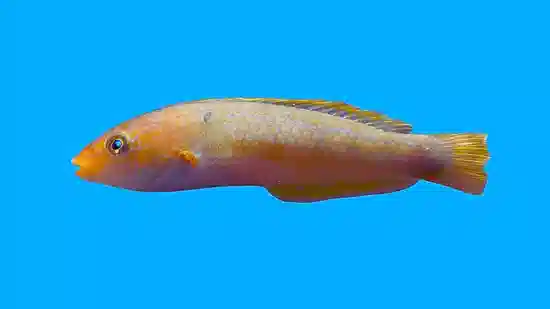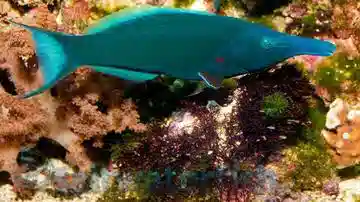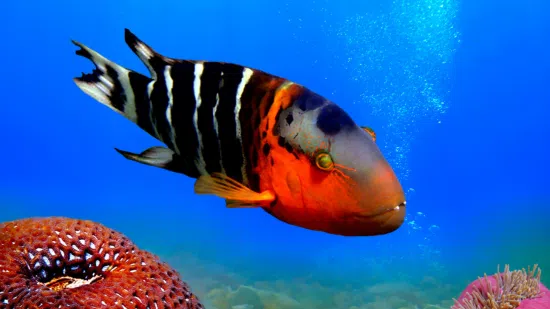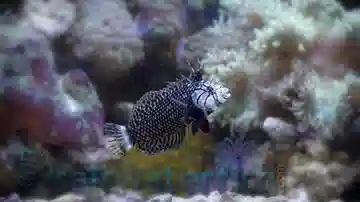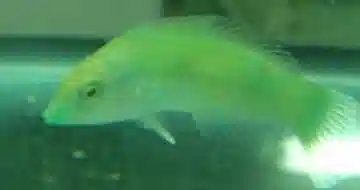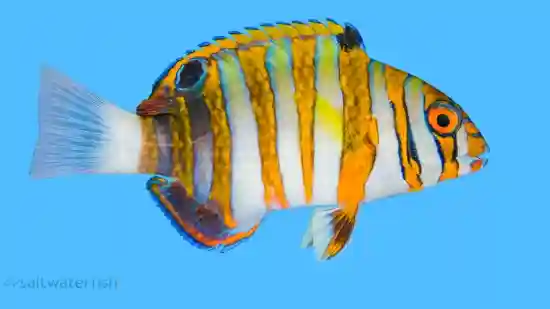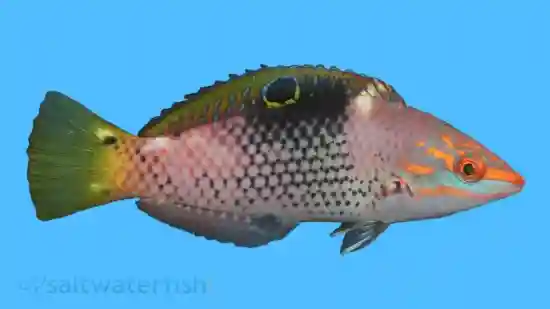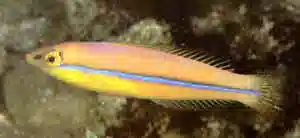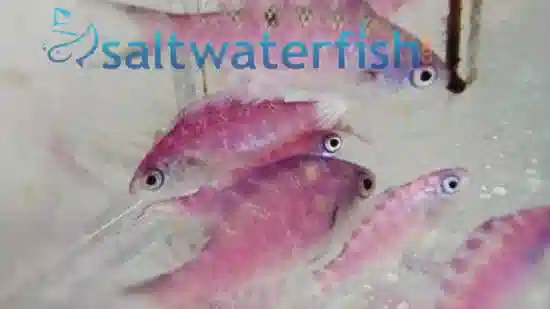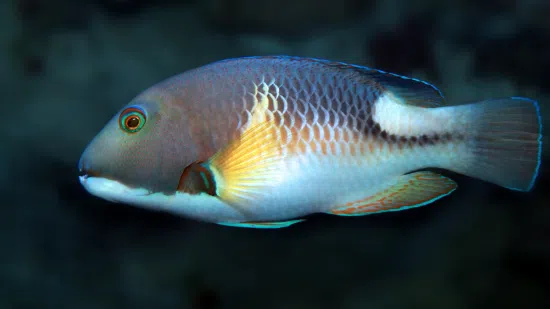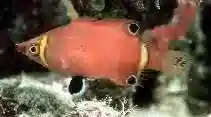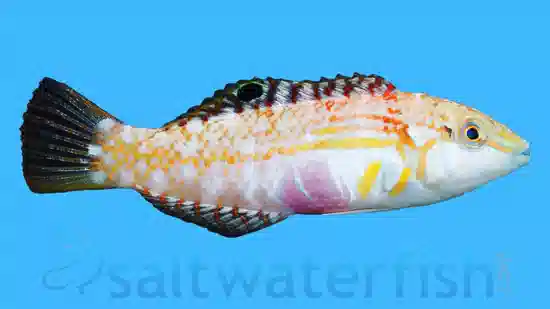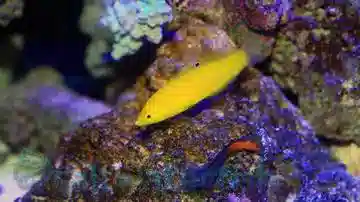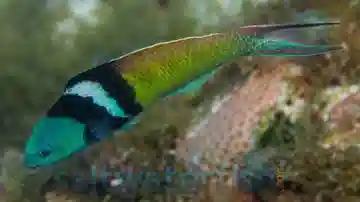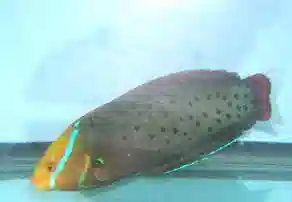Wrasses In Saltwater Aquariums: FAQ
Non–reef safe wrasses, such as the Dragon Wrasse, Bird Wrasse, Banana Wrasse, and Red Coris Wrasse, are known for their bold personalities and strong appetites. Unlike their reef-safe cousins, these wrasses are natural predators and require a protein-heavy diet in captivity to stay healthy and vibrant.
In the wild, they consume crustaceans, mollusks, small fish, and various invertebrates. In captivity, you should mirror this with a variety of meaty foods:
Frozen and fresh seafood – mysis shrimp, krill, chopped clam, squid, and silversides
Prepared foods – high-quality carnivore pellets and sticks designed for large marine predators
Live foods (occasionally) – feeder shrimp, mollusks, or blackworms for enrichment and stimulation
Natural hunting – many non–reef safe wrasses will flip rocks and dig in sand to uncover snails, crabs, or worms
Customer reviews reflect this: “My Melanurus Wrasse ate flatworms within hours of being introduced but still comes out for every feeding. Frozen mysis is his favorite\!” (Saltwaterfish.com Reviews, 2024).
Bottom line: Non–reef safe wrasses are active carnivores that need a meaty, varied diet to thrive. From frozen krill and clams to live feeder shrimp, they’ll eagerly accept most foods you provide. Just remember, these wrasses aren’t suitable for reef tanks with invertebrates, but in the right setup, they make hardy, fascinating show fish. Backed by Saltwaterfish.com’s 8-Day Live Guarantee, they’re a rewarding choice for predator and FOWLR aquariums.
Caring for non–reef safe wrasses like the Dragon Wrasse, Bird Wrasse, Banana Wrasse, and Red Coris Wrasse requires planning for their size, activity level, and predatory nature. These wrasses grow quickly, develop strong jaw structures, and are known to flip rocks and dig into substrate in search of prey.
To keep them healthy and thriving, focus on four key care areas:
Tank size & environment – Provide at least 125+ gallons for larger wrasses like the Dragon and Bird Wrasse. Use a fine sand substrate since many species bury themselves at night. Secure live rock to prevent toppling from their digging behavior.
Diet – Feed a protein-rich diet of frozen krill, squid, clams, silversides, and high-quality carnivore pellets. Offering shelled foods supports natural jaw exercise.
Tankmates – These wrasses are not reef safe; they will eat crabs, snails, and shrimp. Instead, pair them with other robust fish such as tangs, triggers, or large angels in a FOWLR (fish-only with live rock) system.
Behavioral enrichment – Their curious, active nature means they benefit from regular feedings (2–3 times daily) and rockwork that allows for exploration and hunting.
One Saltwaterfish.com Lunare Wrasse buyer shared: “Nice addition to fish only tank. Arrived healthy and is a very active and nice colorful fish. Easy keeper-Eats a variety of meaty, pellet, and flake foods. Peaceful and gets along great with our angels and butterfly fish.” — Saltwaterfish.com Customer Review.
Bottom line: Non–reef safe wrasses demand space, a meaty diet, and strong tankmates. They won’t work in reef setups, but in predator or FOWLR aquariums, they reward aquarists with color, personality, and constant activity. Choose yours at Saltwaterfish.com with confidence, backed by our 8-Day Live Guarantee.
Wrasses are one of the most diverse families of saltwater fish, with sizes that range from tiny reef dwellers to large, predatory species. In a home aquarium, their maximum size depends heavily on the species you choose, since growth is strongly influenced by genetics, tank space, and diet.
Typical sizes of wrasses in aquariums:
Small reef-safe wrasses (2–4 inches): Flasher Wrasses (Paracheilinus spp.), Pink-Streaked Wrasse (Pseudocheilinops ataenia), and some Fairy Wrasses (Cirrhilabrus spp.) stay under 4 inches, making them ideal for nano and medium reef tanks.
Medium wrasses (4–6 inches): Six-Line Wrasse (Pseudocheilinus hexataenia), Melanurus Wrasse (Halichoeres melanurus), and Yellow Coris Wrasses typically grow to 5–6 inches.
Large wrasses (8–12 inches): Christmas Wrasses and other Halichoeres species can exceed 8 inches in mature reef systems.
Extra-large, non-reef-safe wrasses (up to 18 inches+): Lunare Wrasse (Thalassoma lunare), Dragon Wrasses, and Banana Wrasses can grow well over a foot and are best left for large FOWLR (fish-only with live rock) aquariums.
Pro tips for managing wrasse growth in aquariums:
Always research the adult size before purchase. Many species are small at first but outgrow smaller tanks.
Provide an appropriate tank: most Fairy and Flasher Wrasses thrive in 50–75 gallons, while larger Halichoeres and Thalassoma wrasses need 100+ gallons.
Feed a varied, protein-rich diet to support natural growth and vibrant coloration.
One Saltwaterfish.com Labout's Fairy Wrasse buyer shared: “This Wrasse is hands down my favorite and came super colorful and healthy. These fish are hard to come by so I would recommend getting one of these if you are lucky enough to find them available.”* — Saltwaterfish.com Customer Review.
Bottom line: Wrasses in home aquariums range from 2 inches to over 12 inches , depending on the species. Most popular reef-safe wrasses stay in the 3–6 inch range, making them colorful and manageable additions to reef tanks, backed by Saltwaterfish.com’s 8-Day Live Guarantee.
Yes, wrasses are notorious jumpers. Their natural instinct to dart quickly when startled often leads them to leap out of uncovered aquariums. This behavior is especially common during acclimation or when tankmates chase them.
To keep your wrasse safe, consider these proven strategies:
Tight-fitting lid or mesh top – Use a secure cover with no gaps. Many aquarists prefer clear mesh netting, which maintains gas exchange and light penetration.
Tank size and structure – Provide ample swimming room (125+ gallons for larger wrasses) and stable rockwork to reduce stress-related dashing.
Acclimation time – Wrasses are most prone to jumping during their first days in a new aquarium. Keeping lights dim and tankmates calm helps them settle.
Burying behavior – Many wrasses bury themselves in sand to sleep. Without sufficient substrate, they may attempt to leap when seeking shelter.
One Saltwaterfish.com Green Bird Wrasse buyer shared: “Very big , colorful and very lively upon arrival. Saltwaterfish.com rocks every time.” — Saltwaterfish.com Customer Review.
Bottom line: Wrasses are high-risk jumpers, especially large, non–reef safe species known for their strength and energy. A secure lid isn’t optional, it’s essential. Protect your investment and enjoy their bold personalities by providing the right environment, backed by Saltwaterfish.com’s 8-Day Live Guarantee.
Non–reef safe wrasses are some of the most striking fish available, but they’re also among the largest wrasses kept in home aquariums. Unlike the smaller reef-safe fairy or flasher wrasses, species like the Dragon Wrasse, Bird Wrasse, Banana Wrasse, and Red Coris Wrasse can easily reach sizes that make them the centerpiece of a FOWLR (fish-only with live rock) system.
Typical adult sizes of some of the largest non-reef safe wrasses in captivity include:
Dragon Wrasse – up to 12 inches; known for its dramatic “juvenile dragon” appearance that transforms into a bold adult coloration
Bird Wrasse – 10–12 inches; very active swimmers requiring lots of open space
Banana Wrasse – 10 inches; bright green-yellow body, hardy, and fast-growing
Red Coris Wrasse – 10–12 inches; brilliant red-orange adult coloration, but starts as a very different juvenile pattern
One Saltwaterfish.com Dusky Wrasse buyer shared: “Saltwaterfish.com sent me an absolutely gorgeous dusky wrasse. This species of wrasse, like many, does not always handle shipping well (I lost one in the past for no apparent reason one day after it arrived). I took care to minimize its stress by leaving the lights off in the quarantine tank for the first couple of days. One week in he's active, eats like a champ, and doing great.” — Saltwaterfish.com Customer Review.
Bottom line: Non–reef safe wrasses are large, fast-growing fish, with most species reaching 10–12 inches in captivity. They demand spacious tanks (125+ gallons), meaty diets, and strong tankmates. If you’re looking for a bold showpiece for your predator or FOWLR aquarium, these wrasses deliver unmatched size, color, and personality, backed by Saltwaterfish.com’s 8-Day Live Guarantee.
Non–reef safe wrasses are powerful, active fish that require careful acclimation to thrive in a FOWLR (fish-only with live rock) system. Because these species grow large, dig, and hunt invertebrates, acclimation isn’t just about water chemistry, it’s about ensuring they adapt smoothly to a tank designed for their behaviors.
Steps to successfully acclimate non–reef safe wrasses:
Float and drip acclimate – Start by floating the sealed bag for 15–20 minutes, then drip acclimate over 45–60 minutes to slowly equalize pH, temperature, and salinity.
Dim the lights – Wrasses are nervous during transfer; subdued lighting reduces stress and prevents frantic dashing.
Sand bed access – Provide a fine sand substrate (2–3 inches). Many wrasses bury themselves at night or when frightened. Without sand, they may injure themselves or jump.
Rockwork security – These wrasses are known for flipping rocks while hunting. Secure live rock to avoid collapses during exploration.
Tankmate timing – Introduce them last in aggressive FOWLR setups, as their active swimming and bold personalities can provoke territorial disputes.
One Saltwaterfish.com Harlequin Tusk Wrasse buyer shared: “A gorgeous healthy Harlequin Tusk. Arrived quickly and adapted quickly. Likes to hang out with my Mimic Tang. I purchased three different species and everyone is doing well\!”* — Saltwaterfish.com Customer Review.
Bottom line: Acclimating non–reef safe wrasses to a FOWLR tank requires patience, sand for burying, and secure rockwork. With slow drip acclimation and a stress-free environment, these bold species settle quickly and reward you with vibrant color, personality, and non-stop activity, backed by Saltwaterfish.com’s 8-Day Live Guarantee.
Clownfish are hardy, semi-aggressive fish that often pair well with larger, bold tankmates in a FOWLR (fish-only with live rock) aquarium. Many non–reef safe wrasses can coexist successfully with clownfish when housed in large, well-structured tanks.
Mid-to-large species that can pair with clownfish in FOWLR tanks:
Formosa Wrasse – Can grow 16–20 inches, powerful digger and shell crusher.
Lyretail Wrasse – Striking coloration, active swimmer, reaches 10 inches.
Bluehead Wrasse – Hardy species, males develop a bright blue head, grows to 8 inches.
Rainbow Wrasse – Adds color variation, active and bold personality, grows to 8–10 inches.
Why they’re compatible:
Different niches – Clownfish typically stay near anemones, rockwork, or a corner of the tank, while wrasses are open-water swimmers or sand-buriers. This separation reduces conflict.
Similar aggression levels – Both clowns and non–reef safe wrasses can be assertive, but in a spacious system (125+ gallons), they usually establish territories without long-term issues.
Feeding habits – Both species are opportunistic feeders that readily accept frozen mysis, krill, clams, and pellets, simplifying diet planning.
Best practices for pairing wrasses with clownfish:
Introduce clownfish first, then add wrasses later to avoid territorial disputes.
Avoid housing very small or juvenile clownfish with large wrasses, as wrasses may harass or outcompete them.
Maintain stable rock structures; digging wrasses may shift décor that clownfish use for shelter.
Keep compatible tankmates overall. Tangs, angels, or triggers often balance these setups well.
One Saltwaterfish.com Bluehead Wrasse buyer shared: “Beautiful fish\! Hardy and adapts well to aquarium life. It is one of my favorites for reef aquariums. Always busily swimming around the tank. Thank you saltwaterfish.com for another great order\!”* — Saltwaterfish.com Customer Review.
Bottom line: In large FOWLR aquariums, non–reef safe wrasses and clownfish usually make excellent tankmates. With plenty of space, secure rockwork, and a balanced introduction, they coexist peacefully while bringing color and personality to your system, backed by Saltwaterfish.com’s 8-Day Live Guarantee.
It’s possible to keep multiple wrasses in the same aquarium, but success depends on choosing the right species, providing a large tank, and understanding their natural behaviors. Non–reef safe wrasses like the Formosa Wrasse, Lyretail Wrasse, Bluehead Wrasse, and Rainbow Wrasse are bold, predatory fish that grow large and establish territories quickly. In smaller systems, that often leads to conflict.
Best practices for keeping multiple wrasses together:
Tank size – A minimum of 180 gallons is recommended for keeping more than one large wrasse. Formosa Wrasses alone can grow over 16 inches.
Species mixing – Avoid combining wrasses of the same genus (e.g., two Thalassoma wrasses) as they compete directly and may fight. Mixing across genera (e.g., a Formosa Wrasse with a Lyretail Wrasse) has a higher success rate.
Introduce simultaneously – Adding wrasses at the same time prevents one from establishing dominance before the other arrives.
Plenty of rock and sand – Rockwork for hiding and sand for burying reduce stress and allow natural behaviors.
Tankmates balance – Other assertive fish like tangs or large angels can help diffuse aggression by keeping wrasses from targeting each other exclusively.
One Saltwaterfish.com Pudding Wife Wrasse buyer shared: “He is a colorful little guy to watch darting around the tank. He is constantly on the move searching for food or detritus on the bottom as well as on reef rock. Likes to dart in and out of rock. He is getting much better at snagging Mysis shrimp I drop in before the other 6 fish hog it all, especially my Hamlet Indigo who gobbles everything that moves. A joy to watch.
”* — Saltwaterfish.com Customer Review.
Bottom line: Yes, you can keep multiple wrasses together in a large FOWLR tank, but it requires careful planning. Stick to very spacious aquariums, avoid same-species combinations, and provide plenty of structure. When done right, multiple wrasses add color, activity, and personality, backed by Saltwaterfish.com’s 8-Day Live Guarantee.
If you’re just starting out with a FOWLR (fish-only with live rock) aquarium, choosing hardy wrasses is key. While many wrasses are sensitive or grow very large, several non–reef safe species adapt well to aquarium life, eat readily, and tolerate beginner mistakes better than most. Among the best options at Saltwaterfish.com are:
Bluehead Wrasse – Reaches 8 inches, very hardy, eats almost anything, and acclimates quickly.
Rainbow Wrasse – 8–10 inches, brightly colored, active, and forgiving of water quality fluctuations.
Formosa Wrasse (Cheilinus formosus) – Larger (16–20 inches) but considered very durable once established. Eats a broad range of foods and adapts well to tank life.
Banana Wrasse – Around 10 inches, extremely hardy and long-lived, though very active and best for larger tanks.
Why these wrasses are great for beginners:
They are aggressive feeders, accepting frozen mysis, krill, clams, and pellets from day one.
They tolerate a range of water conditions better than more delicate wrasses.
Their bold personalities and constant activity make them entertaining and easy to monitor for health.
They’re less prone to hiding for long periods compared to sensitive fairy or flasher wrasses.
One Saltwaterfish.com Orange Spotted Tuskfish buyer shared: “A great fish to keep it came healthy and was eating the very first day. Very fast to get with other tankmates after the first day. Beautiful colors.” — Saltwaterfish.com Customer Review.
Bottom line: For new aquarists setting up a FOWLR system, hardy wrasses like the Bluehead, Rainbow, Lyretail, and Banana Wrasse are excellent starter choices. They combine adaptability, bold color, and durability, backed by Saltwaterfish.com’s 8-Day Live Guarantee.
Wrasses are one of the most diverse families of saltwater fish, with species that fit both reef aquariums and FOWLR (fish-only with live rock) systems. Whether a wrasse is “reef safe” depends on the species, since their feeding habits and behaviors vary widely.
Reef-safe wrasses – Fairy wrasses (Cirrhilabrus), flasher wrasses (Paracheilinus), six-line wrasses (Pseudocheilinus), and melanurus wrasses (Halichoeres melanurus) are all considered safe for reef aquariums. They typically stay small (2–5 inches), leave corals alone, and actively hunt pests such as flatworms and pyramid snails. These wrasses are colorful, peaceful, and thrive in mixed reef communities.
Non–reef safe wrasses – Larger, predatory wrasses like the Dragon Wrasse, Banana Wrasse, Formosa Wrasse, and Red Coris Wrasse are better suited for FOWLR tanks. These species can reach 10–20 inches, flip live rock while hunting, and readily consume crabs, shrimp, snails, and other invertebrates, making them unsuitable for reef systems.
How to choose the right wrasse:
For pest control and color in a reef tank, stick with fairy, flasher, or six-line wrasses.
For a showpiece predator in a FOWLR system, larger wrasses like Dragon or Formosa are excellent choices.
Consider tank size. Reef-safe wrasses thrive in 55–90 gallons, while non–reef safe species often need 125+ gallons.
One Saltwaterfish.com Yellow Banded Possum Wrasse buyer shared: “A cute, little, lively Yellow Banded Possum Wrasse that brings a lot of character to your tank. Seems to play well with others and makes a welcome addition while being an easy keeper.”* — Saltwaterfish.com Customer Review.
Bottom line: Wrasses can be either reef safe or FOWLR predators, depending on the species. Choose fairy, flasher, or six-line wrasses for coral tanks, or opt for Dragon, Banana, or Formosa Wrasses as bold centerpieces in fish-only systems, backed by Saltwaterfish.com’s 8-Day Live Guarantee.

